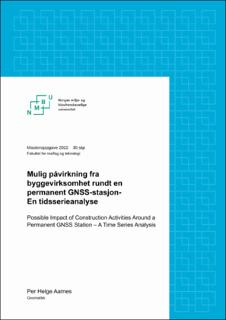| dc.contributor.advisor | Øvstedal, Ola | |
| dc.contributor.advisor | Rost, Christian | |
| dc.contributor.author | Aarnes, Per Helge | |
| dc.coverage.spatial | Norway, Oslo | en_US |
| dc.date.accessioned | 2022-10-28T08:21:13Z | |
| dc.date.available | 2022-10-28T08:21:13Z | |
| dc.date.issued | 2022 | |
| dc.identifier.uri | https://hdl.handle.net/11250/3028772 | |
| dc.description.abstract | Denne mastergradsoppgaven omhandler fagområdet geomatikk og er skrevet på oppdrag fra Norsk Romsenter. Formålet med studien er å se om byggevirksomheten i Bjørvika har påvirket posisjonsnøyaktigheten til en permanent GNSS-stasjon på operahuset. Studien omfatter analyser i både observasjons- og koordinatdomenet. Beregningene i koordinatdomenet gjøres i RTKLIB, og består av en baselinjeberegning og en presis enkeltpunktsbestemmelse (PPP). Analysen gjøres på grunnlag av en tidsserie med ulike GNSS-observasjoner i perioden fra 2010 og frem til 2022. Som en konsekvens av at Bjørvika synker, blir resultatene kryssvalidert ved hjelp av «Syntetisk Apertur Radar Interferometri» (InSAR).
Resultatene fra analysen i observasjondomenet viser at byggevirksomheten har ført til en økning av flerveis-interferens for signalet C1C for GPS og GLONASS. RMS-verdien til dette signalet har økt med 37% og 31% for henholdsvis GPS og GLONASS. Det ble imidlertid ikke påvist en signifikant økning på de andre signalene som inngår i analysen. Estimatene av flerveis-interferens viser også at signalet E5AltBOC er mere robust mot flerveis-interferens sammenlignet med andre signaler. Resultatene fra baselinjeberegningen viser at avviket i øst-komponenten også har økt i samme periode. Tidspunktet for økningen i begge domenene sammenfaller med perioden det var størst byggeaktivitet i Bjørvika.
Når det gjelder PPP-løsningen er presisjonen for lav og varierende til at det kan trekkes slutninger om endring i posisjonsnøyaktighet. Det ble videre ikke påvist at setningsproblematikken i Bjørvika har ført til en signifikant nedsynking av operahuset.
Basert på resultatene ble det konkludert med at byggevirksomheten i umiddelbar nærhet av stasjonen har påvirket posisjonsnøyaktigheten og at signalet E5AltBOC, i større grad enn andre signaler, klarer å kompensere for lokale endringer. | en_US |
| dc.description.abstract | This master’s thesis deals with the field of geomatics and is written on behalf of the Norwegian Space Agency. The study aims to determine whether the construction activity in Bjørvika has affected the position accuracy of a permanent GNSS-station on the roof of the opera house. The analysis is based on a series of different GNSS observations in the period from 2010 to 2022 and comprises an analysis in both the observation- and coordinate domain. The computations in the coordinate domain involves the use of RTKLIB and consist of a relative GNSS-solution and a precise point positioning (PPP). Due to the fact that Bjørvika suffers from subsidence, the results were cross-validated using «Synthetic Aperture Radar Interferometry» (InSAR).
The results from the analysis in the observation domain show that the construction activity has led to an increase of the multipath effect for the signal C1C for GPS and GLONASS. The RMS value of this signal has increased by 37 % and 31 % for GPS and GLONASS, respectively. However, no significant increase of the multipath effect was found for the other signals. In addition, the multipath estimates show that the E5AltBOC signal performs better compared to other signals in the case of distinguishing direct from indirect signals. Furthermore, the results from the relative GNSS solution show that the deviation in the eastern component has also increased over the same period. The time of the increase in both domains coincides with the period when the construction activity in Bjørvika was at its highest.
Regarding the PPP solution, the precision is too low for a conclusion to be drawn about changes in position accuracy. Furthermore, it was not proven that the subsidence problem in Bjørvika has led to a significant displacement of the opera house.
Based on the results, a conclusion is made that the construction activity in the immediate vicinity of the station has affected the position accuracy and that the E5AltBOC signal is able to compensate for local changes to a greater extent than other signals. | en_US |
| dc.language.iso | nob | en_US |
| dc.publisher | Norwegian University of Life Sciences, Ås | en_US |
| dc.rights | Attribution-NonCommercial-NoDerivatives 4.0 Internasjonal | * |
| dc.rights.uri | http://creativecommons.org/licenses/by-nc-nd/4.0/deed.no | * |
| dc.subject | GNSS | en_US |
| dc.subject | Flerveis-interferens | en_US |
| dc.subject | Multipath | en_US |
| dc.subject | Posisjonsnøyaktighet | en_US |
| dc.subject | Byggevirksomhet | en_US |
| dc.title | Mulig påvirkning fra byggevirksomhet rundt en permanent GNSS-stasjon : en tidsserieanalyse | en_US |
| dc.title.alternative | Possible impact of construction activities around a permanent GNSS station : a time series analysis | en_US |
| dc.type | Master thesis | en_US |
| dc.description.localcode | M-GEOM | en_US |

